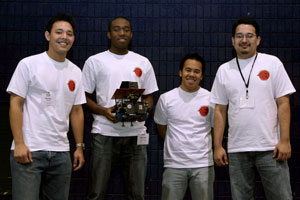One University of Houston robotics team won a lot more than a competition at the 2009 IEEE Region 5 Technical, Professional and Student Conference Saturday.
A successful 67-second final run by their light sensing, autonomous robot secured the group a place in UH history as the first, ever, to take home a regional win at the competition.
But the team led by Paul Dinh and comprised of electrical and computer engineering seniors Ibrahima Komara, Paul Moreno and Thomas Packer are not the only ones with bragging rights.
A second team competing for the university—who relied on four robots to work together to complete the competition mission—helped ensure the university another top spot when their robots scooted past competitors for third.
“I have been jokingly telling teams the last few years that we have gotten second and third, now it’s time to get first,” said John Glover, professor of electrical and computer engineering and the robotics teams’ advisor. “I guess now I’ll have to joke with them about getting first and second.”
Under the direction of Glover, engineering students have been contenders in the annual robotics competition since 2000. Up until this year, only two other teams have ranked in the top three. And while multiple teams have competed in a year, none have been able to capture two of the top three spots.
At the Lubbock competition, the two UH groups faced off with more than 20 other teams from Louisiana, Illinois, Missouri, Arkansas, Colorado, South Dakota, Texas and Oklahoma.
The robots competed on a square track equipped with five flashing LED lights, one in each of the four corners with the fifth poised over the center. The robots were programmed by the students to recognize the LED lights and the different frequencies each was emitting.
At the start of each run, judges gave the teams a random sequence of corners to visit. The robots relied on the different frequencies to guide them to the corners in the correct order, grab a box and carry it to the center of the track where they determined the color of the box and placed it in its corresponding colored square. The run was not complete until all four boxes were delivered to their correct squares.
For much of the fall 2008 semester, students were conceptualizing how their robots would look and move. By spring, students were bringing their ideas to life—cutting framework, constructing circuit boards and programming them for the task at hand.
“We went with a pretty risky design to try and deal with a few of the shortcomings from previous years; we had to think outside of the box,” said Dustin Drawhorn, captain of the four-robot team made up of Melissa Greer, Jesse Maricelli and Leif Bagge. “We may have been a little naïve. It turned out to be four times the work and four times the troubleshooting.”
In order to ensure the more accurate operation of the four-robot design, all had to be carefully programmed.
“They weren’t the same,” Drawhorn said. “They were all like different little people, but I feel pretty good about it. In the end, our design is what allowed us to place.”
Despite the unforeseen challenges and months of hard work, members from both teams said it was all worth it.
For Dinh the experience not only solidified what he was learning in his classes, but also helped him further expand on those fundamentals.
“Being part of this really taught me a lot about the ins and outs of robotics,” said Dinh. “I got a taste of it in Dr. Glover’s embedded systems course, but this really challenged me to work with a team and expand on what Dr. Glover was teaching us.”
